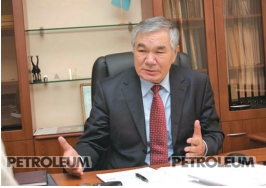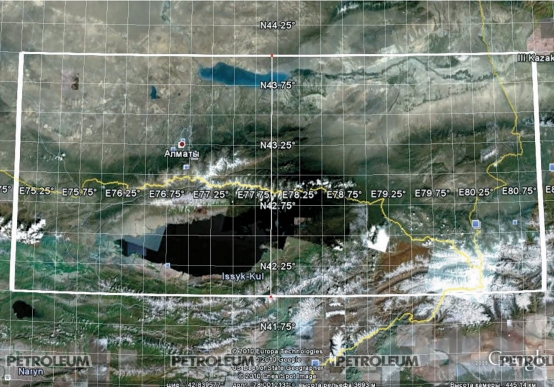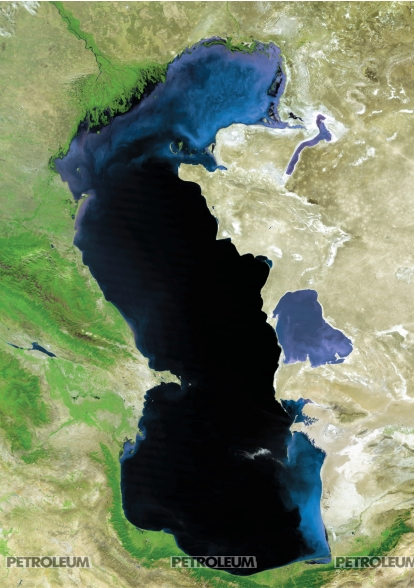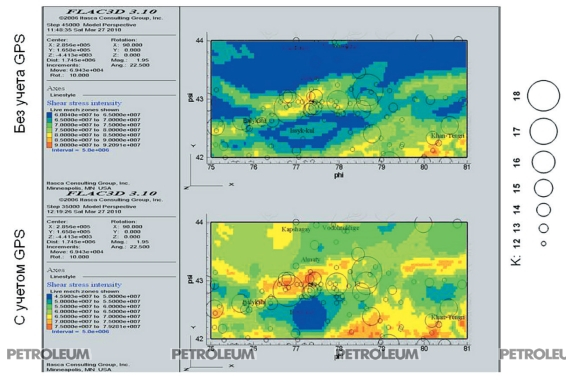The Issue’s Focus: Technology
Space Technology at the Service of the Oil-industry
Amina Jalilova
Coincidentally, that Kazakhstan is now actively involved in space exploration and seriously set about searching for new oil fields imbedded at great depths. What unites these two areas? As it turned out, space technology has long been used by oil and gas companies for geological exploration and to monitor the condition of pipe lines, as well as many other tasks. President of JSC "National Center of Space Research and Technology" Zhumabek Zhantaev told in an interview to the Petroleum not only about what outer space has to offer to the oil industry, but also about the work done in Karachaganak and Tengiz.
- Please tell us about the ground-space, geodynamic and geophysical monitoring of Earth’s crust of Kazakhstan.What is it?And whether it is possible to search for mineral deposits from outer space?
- Experience of working with space images confirms that their use in geology can be very successful. The main idea of prospecting using Earth's remote sensing (ERS) data consists of review schemes and maps compilation. Using them, structure-forming elements can be identified and outlined, which can be linked to mineralization or hydrocarbon deposits. This may be breaks, circular structures, tectonic structures of various order, including local structures (folds and salt domes that are advantageous from the standpoint of oil-bearing). Analysis of structural forms correlation enables prediction of mineral resources based on indirect indicators.
 Space Technology at the Service of the Oil-industry
Space Technology at the Service of the Oil-industry
Direct exploration of mineral deposits have been made possible by virtue of multispectral photography. Change in brightness of geological objects in different narrow spectral bands may be a result of certain chemical elements accumulation. Their anomalous presence can be direct or indirect indication of the possible existence of mineral deposits. Analysing brightness correlation of geological structures in different bands of spectrum, you can identify the known deposits and detect new promising areas, similar to the existing. Based on this principle directories are created, containing brightness of emissions for certain types of rock formations or their combinations, which are used in order to determine the presence or absence of a search object.
Space images allow you to see the structures associated with known hydrocarbon deposits. And on that basis to establish and clarify the boundaries of oil and gas bearing basins, examine the common factors of their localization, present the prognosis evaluation of oil-and-gas content and determine the direction of high-priority prospecting works. Therefore, space geology becomes an essential element in the process of oil search, significantly reducing the cost of ground operations.
Benefits from the use of space techniques are evident. Firstly, they are tens times cheaper than the ground-based. Secondly, they allow to cover larger areas. And, thirdly, they significantly narrow down the search area of traditional methods.
 Space Technology at the Service of the Oil-industry
Space Technology at the Service of the Oil-industry- How does space research might help geologists in practice?Do you collaborate with scientific research institutes, mining companies?What are the results of collaboration?
- In addition to searching for oil fields, space research using method of radar satellite imagery (SAR Interferometry) can help all subsoil users to undertake area’s full-scale territory geodynamical zoning, where the production of hydrocarbons takes place. The purpose of such zoning is to identify areas with anomalous technogenic burden on deposit, which appears in the subsidence of the Earth's surface as a result of the pumping of hydrocarbons. The result of these studies is presented in the form of a vertical displacements maps for the period of examination or speed of vertical displacements in mm/year, allowing to give a prognosis evaluation of deformation processes in the Earth’s crust. Thereby, in the case when preventive measures to ensure environmental and geodynamic safety are applied, it is possible to timely adjust the plans of mining operations and even to prevent irreversible effects.
Modern capabilities of SAR interferometry can also be effectively used in solving the tasks related to the exploration and development of oil and gas fields not only during the regional and prospecting stages, but also during the stages of exploration and production.
On the stages of the exploration and production RSA interferometry can be used for:
- evaluating the air-tightness of the tectonically screened traps of hydrocarbons and underground gas storages;
- typification of faults which complexify oil and gas fields: on channels (currently active fructure systems in the tensile phase) and screens (closed and fixed fissure systems, that are in a state of compression);
- prediction of fracture system in the carbonate reservoirs, characterised by increased filtration-volumetric characteristics;
- evaluating modern mobility of blocks and discontinuous faults for the purpose of engineering the field development system of oil and gas, since the active faults can contribute to the rapid flooding of deposits. Particularly effective is an estimate of the salt domes growth rate, averaging few centimetres per year;
- evaluating horizontal and vertical displacements along the faults, identified within deposits, in order to locate possible leaks of hydrocarbons and inter-stratal flows, that are affecting the local loss of pressure and production decline.
All tusks must be solved in a complex manner, involving geoscience data, as well as cosmic and topographic maps that were used in the previous stages of the work.
“EcoGeoMunaiGas” company, which performs monitoring of the Karachaganak field, signed a contract this year with the “Institute of Ionosphere” JSC "National Center of Space Research and Technology" to perform the geodynamic monitoring using satellite radar data. The results are planned for the year 2016. Currently CosmoSkyMed (Italy) satellite constellation surveys the territory of the deposit.
- On the Caspian Sea shelf objects are constructed worth millions of dollars, wells are drilled, people are working. Meanwhile, the area is seismically active.Is it possible to predict earthquakes, track the crustal activity on the shelf?What work is being done in this direction?
- The Caspian Sea shelf is not related to the zones of high seismicity. For this reason, it is rather related to the induced seismicity. The concept of induced seismicity came into common use mainly as the result of anthropogenic activity. Therefore the geoecological forecasting and environmental monitoring are today’s priority for all areas of the human activity. This especially applies to the objects of the oil and gas sector, ranging from prospecting and production organization to transportation and processing of raw materials. On almost all stages of the selected production cycle, there maybe situations that lead to the disruption of ecological balance in nature, to the extent of catastrophes or disasters. A striking example is the accident at the oil platform in the Gulf of Mexico, that occurred on April 20th, 2015. Its consequences are being studied now and possibly may become irreversible for a variety of biological and natural systems.
A similar situation could happen in the Kazakhstan’s sector of the Caspian Sea, in particular, at the Kashagan.
It is obvious that in order to prevent possible accidents and the oil outflow, it is necessary to take adequate measures, such as “geodynamical support”, consisting of monitoring the deformation processes, both on the Earth’s surface and on the surface of the bottom of the sea.
No less important, and sometimes determinative, geodynamical factor, on the oil and gas development objects, is the induced seismicity. Macroseismic events in the form of man-made and induced earthquakes are relatively rare, but their devastating effects, as well as caused socioeconomic and ecological damage, are very extreme. Data analysis, conducted by N.N. Melnikov and others (2009) showed that earthquakes induced by the oil and gas production, with a magnitude from 3 to 7 and above, occur at both oil and gas fields and can lead to a catastrophic distructions. As an example there are Gazli gas field (Uzbekistan), Neftegorskoe (Russia), Lac (France), etc. (Adushkin, Turuntaev, 2005).
Thus, determining factor, leading to a devastating consequences, is the underestimation of the impact of geomechanical processes. Underestimation of the impact of geomechanical processes leads to the formation of conditions suitable for the irreversible geodynamic occurrences, which destroy wells, pipelines, production devices and facilities.
As a result, the production in conditions of the Caspian Sea shelf, requires the highest degree of control in order to eliminate or minimize the geodynamical risk.
- First Vice Minister of Energy Uzakbay Karabalin said that as of now resources and manpower will be aimed at the geological exploration, which practically has not been developed for many years. Moreover, now the search for oil should occur at a greater depth. Of course, business requires innovations in order to make the process of exploration less costly.How can “Kazcosmos” help oil workers in this case?
 Space Technology at the Service of the Oil-industry
Space Technology at the Service of the Oil-industry
- Indeed, deposits located at shallow depth are mostly explored, and search for the new, including deep seated, using traditional techniques proves to be costly and time-intensive. Following statistics are provided. Worldwide average cost, using traditional methods, at the prospecting stage is from 3 to 5 thousand dollars/km2. At the exploration stage when choosing place for drilling, using seismic 3D method, cost is at least 10 thousand dollars/km2. Execution of such operations can stretch out for years, and therefore, use of traditional methods proves to be profitable only when it comes to exploration of large and medium anticline oil and gas bearing structures, embedded at shallow depth. Because lately there has been a shift towards the prospecting and exploration of non-anticlinal, non-standard, low-powered, including embedded at a greater depth, deposits of hydrocarbon raw materials, traditional approach is often ineffective, failing frequently and resulting in unreasonable expenses.
This is demonstrated by the succesful prospecting drilling statistics (calculated on productive wells percentage of the total number of prospecting wells). In the USSR, years 1981-1985, when using conventional prospecting scheme, success rate of the prospecting drilling was about 24%, in the United States (1986) - 19,8%, in continental Europe (1986) - 23,8%.
Thus, to the real cost of each productive well drilling, ranging from 3 to 7 million dollars, 10-28 million dollars were added, which were spent on drilling non-productive wells, where hydrocarbon crude resources are not available.



